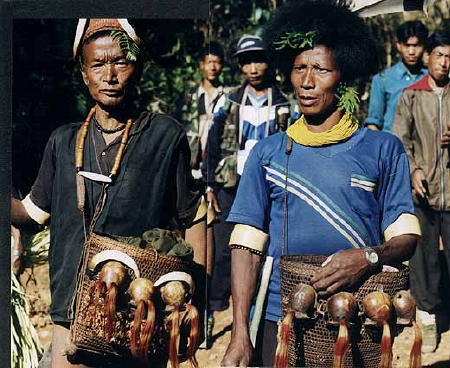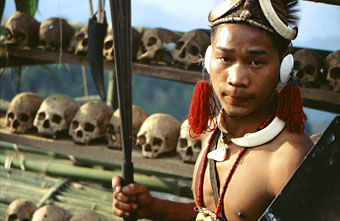





|
|
|
|
March 09, 2007
Nagas with attitude
Where was I? India? Gay porn and Christian forgiveness? I don't know whether there is any way to tie these loose ends together on a Friday afternoon before I lose my head completely, but I'm going to try. I'll start with Ghandi: I do not believe in forced unions. If you (Nagas) do not wish to join the Union of India, nobody will force you to do that.But as the source of the quote makes clear, Ghandi's promise was disregarded: The conflict between the Nagas and India ranks as one of the most persistent and least-known struggles of indigenous peoples in the world today. The Naga Nation, with a population of over 3 million, claims a traditional territory of some 37,000 square miles, straddling the official boundary of India and Myanmar (Burma), from just south of the Chinese border. Following the independence of India and Burma from British control in the late 1940s, Naga territory was divided between the two new states, without Naga consent, and ignoring the Nagas' own declaration of independence. Yesterday, the Economist had a fascinating story about missionaries invading the heart of the largely untamed hill country where the Nagas live. I'm always fascinated by anything having to do with this area, as my dad served there during World War II under General Stilwell, and he used to frighten the wits out of me by showing me pictures of severed children's heads, and telling me true stories about the Naga headhunters. (I've posted about this before, with pictures, of course....) Mentioning the Nagas only in passing, the Economist focused on the Manipuris -- and went a bit out of its way (IMO) to poke fun at invading Missionaries with eating disorders (assuming the account is not exaggerated): ONLY one kind of foreigner slips through Manipur's tight permit regime, and, as I was leaving my hotel today, I encountered a herd of them: Christian missionaries, mostly like this lot, American Pentecostals, come to dispense the Good News and greenbacks to Manipur's hill-tribes.The "biblical struggle" business sounds a bit condescending. And the implication that the Nagas gave up Hinduism is just wrong, as the Nagas were traditional animists who converted to Christianity, and who overwhelmingly oppose Hinduism. But never mind. After Ann Coulter's lesson in tolerance for the week, I don't think I should be taking offense at anything anymore -- especially if that means siding with one group of "noble savages" at the expense of another, or protesting the ridicule of overweight missionaries I have never met. The problem is, because of my childhood, I have an admitted (if spooky) pro-Naga bias. So when I read the Economist I was disppointed, dammit, because I wanted to read about Nagas, not some wimpy lowland Hindu tribe that's allegedly being pestered by Pentecostalists who can't make it up a flight of stairs. (How they're supposed to evangelize primitive hill people I do not know. But again, I don't want to fall into being judgmental....) Now that my bias has been admitted, I'll move along. The Nagas have a long and turbulent history as warriors. Over the centuries, they would often fight with other Naga tribes, and the trophies were of course heads. Not long ago, the minority Nagas in Manipur fought a war with the Kukis, and they're now said to be in a "fragile alliance" with the Meiteis (the group the Economist describes as currently under Pentecostalist seige). Whether the Indian government has a selective policy about allowing missionaries (animist conversions yes, Hindu conversions no) is anyone's guess, but they've been accused of continuing the same divide-and-conquer strategy the British once used in the same area. There's so much irony involved here that it's tough to know where to start. The Nagas would I guess have to be called ex-headhunters, as they've not only been converted to Christianity, but as headhunting has been banned since 1991, it's faded into a sort of collective memory of the past. But the tattooed, former headhunting elders are greatly respected.

as we know, south korea went from 80% buddhist to 50% christian in one generation. mizoram and nagaland are now 99% christian. the naga siege of manipur recently was a clear religious battle: manipuris have refused to convert and so they were being punished by the (ex-headhunter) nagas. once again, praise be to the First Prime Minister of India (Registered Trademark) who invited australian and nz missionaries and gave them free hand in the northeast.I think that might be a little harsh and judgmental, but these days I'm not sure of anything. Anyway, the Nagas have not only become Christian, they've become literate. And in what seems like barely a generation or maybe two at the most, they've gone from the Stone Age to the Internet Age. I kid you not. I found a number of examples, but the following was written by a tough-talking Naga who calls himself "Boss Man," posting on Kuknalim -- "a home for Nagas on the net": The Naga soldiers are just the top in the world - much more than Gurkhas and even US Marines. They can die for their cause standing.I think that might be called a fair warning, but I can't be sure. Boss Man certainly sounds knowledgeable about his people's history. "Meiteis" is a word for Manipuris. I hope it's not a derogatory word, and I hope readers will forgive my cultural insensitivity if it is. (But I don't think it is derogatory, as Wikipedia uses it, and Wikipedia would never use derogatory language, would they?) There's more here in pdf, and another board discussion here (and I am not endorsing any of the opinions expressed at either link!) Today, the Nagas are 90% Baptist -- and Nagaland has been described as "the most Baptist state in the world." (Sorry, but Mississippi is only number two.) This Naga site supplies more background about Baptist evangelizing, as well as the proud history of the Nagas in helping fight the Japanese in World War II: On the other hand, the American Baptist Missionaries started their station at Molung among the Ao tribe and started educating the Naga's and evangelizing the Naga people. Education was an integral part of the mission and converts were educated in their schools. Literacy was the stamp of authority that gave Christianity supremacy over traditional customs and belief. What the missionaries taught was to have a drastic effect on the traditional social fabric of Naga society. The missionaries had little understandings of the working Naga society and made little or no effort to look beyond the surface. When they saw, using beliefs as a yardstick was promiscuity, heathenism, barbarism and ignorance, converts were compelled to make a complete break with the tradition; they were forbidden to drink rice beers, take part in traditional singing and dancing, sleeping in the Morungs, or participating in any of the traditional co-operative activities of the community. They were actively encouraged to emulate their converts in every ways, dress included and to renounce their heathen brethren. The missionaries are even believed to have destroyed traditional artifacts. Many of the administrators of the time disagreed with the missionaries methods and feared they were destroying Naga culture. They would have preferred Naga culture unchanged. They failed to realize that by romanticizing the Naga's as noble savages they were being a paternalistic as the missionaries. They themselves were not blameless. Their administration had introduced a market economy that brought an end to Naga self sufficiency.Let me interrupt right there and refer readers to the Glenn and Helen Show's podcast interview with Claire and Mischa Berlinski. The latter's book -- Fieldwork -- is all about "historical conflicts between missionaries and anthropologists." The subject of the interactions between the Nagas and their neighbors, and the relative roles played by different missionaries over time so intrigued me (and so reminded me of the interview about the Berlinski book) that I had originally titled this post "Anthropomissionaries and Baptist Headhunters." A ghastly title, to be sure, and I would have left it that way had not the recent Coulter controversy convinced me that I should try to come up with something catchier. To continue with my hopeless cultural relativism, what about the missionaries? Would the anthropologists grant that they too have a culture? Or are they to be seen simply as antimissionaries with no culture worth preserving? Who gets to decide these things? Are the Nagas less worthy than their Hindu neighbors, even though the former are more primitive and the latter more civilized -- simply because the Nagas are considered "Christian"? (Why would the Economist say they were converted from Hinduism, anyway?) Might the Nagas be getting the short end of the stick because they are seen as both too "primitive" and too "Christian"? Or might it be that their proud warlike nature is considered somehow less than desirable? Again, who gets to decide these things? Back to the text, and to World War II: ....Naga's were to come into even more contact with the outside world and new ideas with the coming of the two world wars.I can vouch for that based on what my father told me. They were tough, proud warriors, but if you could win them over, they were loyal to the death. The two prinicipal battles in the area (Kohima and Imphal) are described here; unfortunately there's not much about the Nagas. However, these were not minor skirmishes. The Japanese advance was stopped, and Supreme Allied Commander Lord Mountbatten compared the allied victory to Thermopylae: Louis Mountbatten latter described the Allied victory at Imphal and Kohima as "probably one of the greatest battles in history,... in effect the Battle of Burma.... [It was] the British-Indian Thermopylae."I found more here, and after hours of web research, I managed to find confirmation (from a non-Naga source) of what my father had always told me -- that the Nagas helped kill Japanese: ....And then there was "the forgotten army" fighting in the Far East. Just as D-Day was decisive in the war in Europe, so the Battle of Kohima, being fought at exactly the same time in north-east India, proved to be the turning point in the Burma Campaign.That's what I call Nagas with Attitude. Don't mess with the Nagas. Nowadays, they seem to be substituting monkey skulls for the human variety.  For now.... But how many young American men can proudly pose like this in front of granddad's skull collection?  Christians? Noble Savages? Victims of missionaries? Victims of a heavyhanded Hindu bureaucracy continuing divide-and-conquer British tactics despite Ghandi's promises? I honestly don't know how to characterize the Nagas. I find myself sympathetic to their goal of independence and self determination, and I find myself liking them, though. (I guess it runs in the family.) posted by Eric on 03.09.07 at 04:30 PM |
|
March 2007
WORLD-WIDE CALENDAR
Search the Site
E-mail
Classics To Go
Archives
March 2007
February 2007 January 2007 December 2006 November 2006 October 2006 September 2006 August 2006 July 2006 June 2006 May 2006 April 2006 March 2006 February 2006 January 2006 December 2005 November 2005 October 2005 September 2005 August 2005 July 2005 June 2005 May 2005 April 2005 March 2005 February 2005 January 2005 December 2004 November 2004 October 2004 September 2004 August 2004 July 2004 June 2004 May 2004 April 2004 March 2004 February 2004 January 2004 December 2003 November 2003 October 2003 September 2003 August 2003 July 2003 June 2003 May 2003 May 2002 See more archives here Old (Blogspot) archives
Recent Entries
• Genocide Question
• Childhood Trauma Leads To Depression • "This Is HUGE!" • Nagas with attitude • the peaceful but angry relativism of violent Ghandian pacificism • "I WAS A GAY PORN STAR!" • HAPPY BIRTHDAY SEAN KINSELL! • War For Profit • How trying to prevent genocide becomes genocide • I Have Not Yet Begun To Fight
Links
Site Credits
|
|